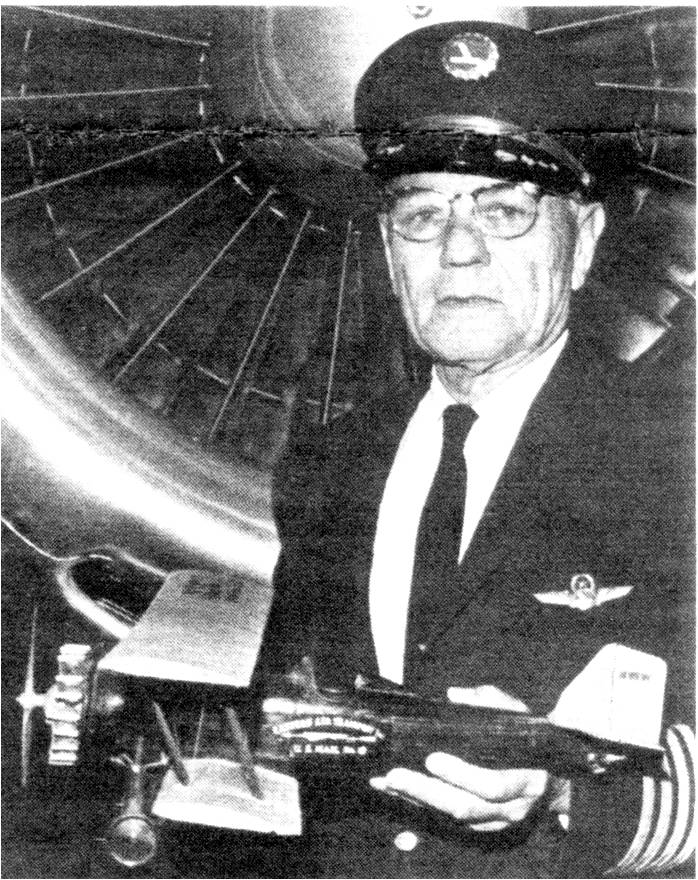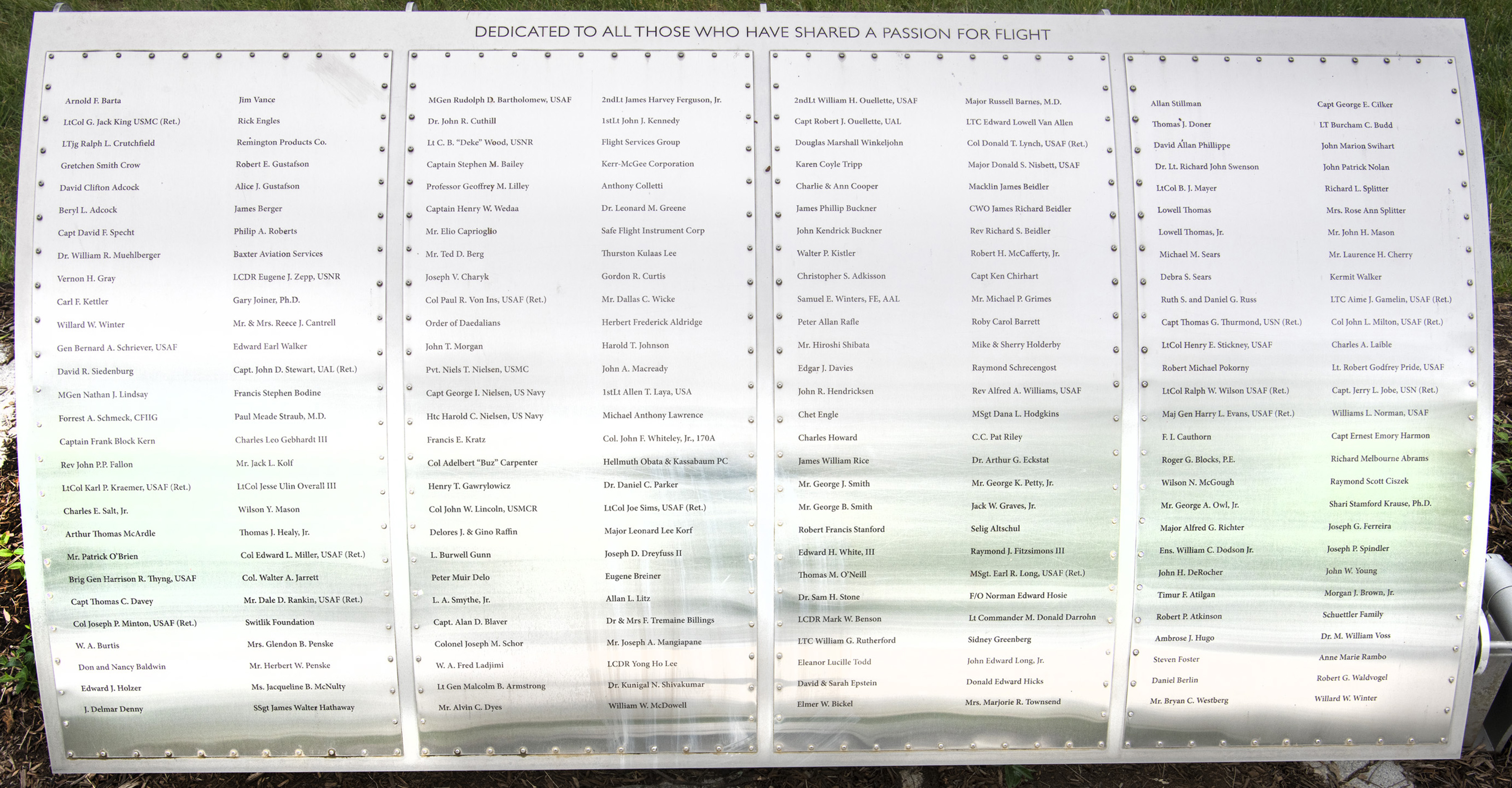
Foil: 26 Panel: 1 Column: 1 Line: 16
Wall of Honor Level: Air and Space Sponsor
Honored by:
Frank Kern was born in St. Louis, Missouri on October 25, 1907. He attended Washington University for a short time and entered the Naval Flight Training Program in May 1926. He trained at Great Lakes Naval Station, Illinois in N-9 aircraft through June 1926. He returned to Great Lakes in June 1927 and then went to Hampton Roads Naval Air Station, Virginia in late June and July 1927 where he flew N-B-2s and T-3-Ms. (Commander Albert C. Read, NC-4 commander, was the Naval Air Station Commander and certified his logbook.)
He was commissioned an Ensign, US Navy Reserve on December 1, 1927 and designated Naval Aviator Number 4435 on December 9, 1927. He returned to Great Lakes in June 1928 where he flew the NY-2.
In July 1928 he reported to Scouting Squadron 2, North Island Naval Air Station, San Diego, California where he flew the FU-2, UO-1, and Vought 02U series. In October 1928, he carrier qualified on the USS Langley, deployed to the USS Saratoga from January through March 1929 and left active duty in July 1929.
Shortly after the Department of Commerce started issuing Aeronautical Licenses in 1927, he obtained License Number 639 that became a Transport Pilot's license in 1929.
In August 1929 he became a Demonstration Pilot for the Curtiss-Robertson Division of the Curtiss-Wright Airplane Company in St. Louis, flying the 'Robin,' 'Thrush,' 'Moth,' 'Condor Model 18,' and 'Kingbird.' He demonstrated a 'Kingbird' to Eastern Air Transport in the summer of 1930 and delivered their first one to them in December 1930.
He was employed by Eastern Air Transport (later Eastern Air Lines) from December 1930 until his federally mandated retirement from flying in October 1967. (He continued as a DC-8 simulator instructor until October 1970.) During this time he flew every type of aircraft operated by that airline, which were Curtiss Kingbird; Curtiss Condor Models 18 and T-32; Ford 5-AT; Pitcairn PA-6, -8; Stinson U and T; Douglas Commercial -2, -3, -4, -6, -7, and -8; Lockheed Models 10 and 188 'Electra,' Models 649, 749, and 1049A, C, and G 'Constellation;' Martin 404; and Convair 340/440. He often flew the DC-3 now displayed in the National Air and Space Museum; the first occasion being December 23, 1937 from Miami, Florida to Atlanta, Georgia.
During the formative years of the Air Line Pilots Association in the early 1930s, he helped establish the union-airline relationship. He later served as the chairman of local chapters in two cities and a regional vice-president. He became a member of the Quiet Birdmen in 1932.
During World War II, Eastern Air Lines operated special cargo flights for the Air Transport Command of the US Army Air Corps. From May 1942 until October 1945, he flew Douglas C-47 type and Curtiss C-46 aircraft from Miami to places such as Borinquen, Puerto Rico; Trinidad, British West Indies; Paramaribo, Dutch Guiana (now Suriname); Georgetown, British Guiana (now Guyana); Belem and Natal, Brazil; Ascension Island; Accra, Gold Coast (now Ghana); and Panama Canal Zone.
From 1947 through July 1961, he served as a flight instructor, Check Captain, Check Airman and Air Line Pilot Examiner. In June 1951, he became the first Superintendent of Flight Crew Training and was also responsible for hiring pilots. During this time Eastern Air Lines transitioned from sophisticated piston-engine airliners to turboprops to jets. On January 3, 1960, he set a speed record in a DC-8 from Long Beach, California to Miami, Florida of 3:58:55 hours only to have it broken several weeks later.
In August 1961, he returned to line flying the DC-8. In mid 1967 he started flying to Europe supporting a US Air Force Military Airlift Command contract. In October 1967, his last flight as an airline Captain, was Eastern's first in support of a Military Airlift Command contract to Vietnam. He accumulated just under 26,500 flight hours in 41 years of flying.
After his airline retirement, he turned his talents to his longtime hobby of photography, both in taking pictures and professionally processing them. As an avocation, he learned how to operate a full size, restored steam locomotive for the Gold Coast Railroad, a tourist attraction in Hollywood, Florida. He died in June 1983.
Note: The following are in the Wall of Honor files of the National Air and Space Society:
1. A photo of Frank B. Kern, Jr, shown in his Eastern Air Transport uniform in the early 1930s
2. A November 1967 photo of Captain Frank B. Kern, Jr in his Eastern Airlines uniform
3. A copy of the logbook entry of his first flight in DC-3 N18124 on December 23, 1937 (the DC-3 is on display in the America by Air Gallery of the National Air and Space Museum on the National Mall)
Wall of Honor profiles are provided by the honoree or the donor who added their name to the Wall of Honor. The Museum cannot validate all facts contained in the profiles.
Foil: 26
